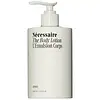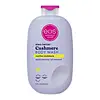What's inside
What's inside
 Key Ingredients
Key Ingredients

 Benefits
Benefits

 Concerns
Concerns

 Ingredients Side-by-side
Ingredients Side-by-side

Water
Skin ConditioningHelianthus Annuus Seed Oil
EmollientGlycerin
HumectantCaprylic/Capric Triglyceride
MaskingNiacinamide
SmoothingShea Butter Glycerides
EmulsifyingCetearyl Olivate
Cetearyl Alcohol
EmollientGlyceryl Stearate
EmollientSorbitan Olivate
EmulsifyingParfum
MaskingAcetyl Heptapeptide-4
HumectantPalmitoyl Dipeptide-5 Diaminobutyroyl Hydroxythreonine
Skin ConditioningPalmitoyl Dipeptide-5 Diaminohydroxybutyrate
Skin ConditioningPalmitoyl Tetrapeptide-7
Skin ConditioningPalmitoyl Tripeptide-1
Skin ConditioningEucalyptus Globulus Leaf Oil
PerfumingSclerocarya Birrea Seed Oil
HumectantCaryodendron Orinocense Seed Oil
EmollientLimnanthes Alba Seed Oil
Skin ConditioningTocopherol
AntioxidantLinoleic Acid
CleansingLinolenic Acid
CleansingPropanediol
SolventXanthan Gum
EmulsifyingPolyacrylate Crosspolymer-6
Emulsion StabilisingCaprylhydroxamic Acid
Caprylyl Glycol
EmollientOleic Acid
EmollientPalmitic Acid
EmollientStearic Acid
CleansingLavandula Angustifolia Oil
MaskingAbies Sibirica Oil
MaskingZingiber Officinale Root Oil
MaskingCitrus Aurantium Dulcis Peel Oil
MaskingPogostemon Cablin Leaf Oil
MaskingLimonene
PerfumingLinalool
PerfumingCitric Acid
BufferingWater, Helianthus Annuus Seed Oil, Glycerin, Caprylic/Capric Triglyceride, Niacinamide, Shea Butter Glycerides, Cetearyl Olivate, Cetearyl Alcohol, Glyceryl Stearate, Sorbitan Olivate, Parfum, Acetyl Heptapeptide-4, Palmitoyl Dipeptide-5 Diaminobutyroyl Hydroxythreonine, Palmitoyl Dipeptide-5 Diaminohydroxybutyrate, Palmitoyl Tetrapeptide-7, Palmitoyl Tripeptide-1, Eucalyptus Globulus Leaf Oil, Sclerocarya Birrea Seed Oil, Caryodendron Orinocense Seed Oil, Limnanthes Alba Seed Oil, Tocopherol, Linoleic Acid, Linolenic Acid, Propanediol, Xanthan Gum, Polyacrylate Crosspolymer-6, Caprylhydroxamic Acid, Caprylyl Glycol, Oleic Acid, Palmitic Acid, Stearic Acid, Lavandula Angustifolia Oil, Abies Sibirica Oil, Zingiber Officinale Root Oil, Citrus Aurantium Dulcis Peel Oil, Pogostemon Cablin Leaf Oil, Limonene, Linalool, Citric Acid
Water
Skin ConditioningSodium C14-16 Olefin Sulfonate
CleansingGlycerin
HumectantSodium Laureth Sulfate
CleansingCocamidopropyl Betaine
CleansingParfum
MaskingTheobroma Cacao Seed Butter
EmollientButyrospermum Parkii Butter
Skin ConditioningButyrospermum Parkii Oil
EmollientHelianthus Annuus Seed Oil
EmollientCetyl Alcohol
EmollientLauramide Mipa
Glycol Distearate
EmollientGuar Hydroxypropyltrimonium Chloride
Skin ConditioningPhenoxyethanol
PreservativeEthylhexylglycerin
Skin ConditioningDisodium EDTA
Sodium Chloride
MaskingSodium Bicarbonate
AbrasiveSodium Benzoate
MaskingSodium Citrate
BufferingPEG-150 Pentaerythrityl Tetrastearate
EmulsifyingAcrylates Copolymer
Polysorbate 20
EmulsifyingTocopheryl Acetate
AntioxidantCitric Acid
BufferingBenzyl Benzoate
AntimicrobialWater, Sodium C14-16 Olefin Sulfonate, Glycerin, Sodium Laureth Sulfate, Cocamidopropyl Betaine, Parfum, Theobroma Cacao Seed Butter, Butyrospermum Parkii Butter, Butyrospermum Parkii Oil, Helianthus Annuus Seed Oil, Cetyl Alcohol, Lauramide Mipa, Glycol Distearate, Guar Hydroxypropyltrimonium Chloride, Phenoxyethanol, Ethylhexylglycerin, Disodium EDTA, Sodium Chloride, Sodium Bicarbonate, Sodium Benzoate, Sodium Citrate, PEG-150 Pentaerythrityl Tetrastearate, Acrylates Copolymer, Polysorbate 20, Tocopheryl Acetate, Citric Acid, Benzyl Benzoate
 Reviews
Reviews

Ingredients Explained
These ingredients are found in both products.
Ingredients higher up in an ingredient list are typically present in a larger amount.
Citric Acid is an alpha hydroxy acid (AHA) naturally found in citrus fruits like oranges, lemons, and limes.
Like other AHAs, citric acid can exfoliate skin by breaking down the bonds that hold dead skin cells together. This helps reveal smoother and brighter skin underneath.
However, this exfoliating effect only happens at high concentrations (20%) which can be hard to find in cosmetic products.
Due to this, citric acid is usually included in small amounts as a pH adjuster. This helps keep products slightly more acidic and compatible with skin's natural pH.
In skincare formulas, citric acid can:
While it can provide some skin benefits, research shows lactic acid and glycolic acid are generally more effective and less irritating exfoliants.
Most citric acid used in skincare today is made by fermenting sugars (usually from molasses). This synthetic version is identical to the natural citrus form but easier to stabilize and use in formulations.
Read more about some other popular AHA's here:
Learn more about Citric AcidGlycerin is already naturally found in your skin. It helps moisturize and protect your skin.
A study from 2016 found glycerin to be more effective as a humectant than AHAs and hyaluronic acid.
As a humectant, it helps the skin stay hydrated by pulling moisture to your skin. The low molecular weight of glycerin allows it to pull moisture into the deeper layers of your skin.
Hydrated skin improves your skin barrier; Your skin barrier helps protect against irritants and bacteria.
Glycerin has also been found to have antimicrobial and antiviral properties. Due to these properties, glycerin is often used in wound and burn treatments.
In cosmetics, glycerin is usually derived from plants such as soybean or palm. However, it can also be sourced from animals, such as tallow or animal fat.
This ingredient is organic, colorless, odorless, and non-toxic.
Glycerin is the name for this ingredient in American English. British English uses Glycerol/Glycerine.
Learn more about GlycerinHelianthus Annuus Seed Oil is the oil derived from the seeds of a Sunflower. Sunflower seed oil is non-fragrant. It is an emollient, meaning it helps to soften the skin.
Sunflower seed oil contains many fatty acids. The fatty acids found in sunflower seeds include (from highest amount to least): linoleic acid, myristic acid, palmitic acid, stearic acid, arachidic acid, oleic acid, and linolenic acid.
These fatty acids help the skin create ceramides. Ceramides play a role in repairing the skin barrier.
Helianthus Annuus Seed Oil helps moisturize the skin. This in turn helps the skin look more rejuvenated and smoother.
Sunflowers are rich in vitamin E.
Historians believe Indigenous cultures of North America domesticated sunflowers before corn. Thus they relied on sunflower oil for a variety of uses. One such use is moisturizing skin and hair.
Sunflower seed oil may not be fungal acne safe. We recommend speaking with a professional if you have any concerns.
Learn more about Helianthus Annuus Seed OilParfum is a catch-all term for an ingredient or more that is used to give a scent to products.
Also called "fragrance", this ingredient can be a blend of hundreds of chemicals or plant oils. This means every product with "fragrance" or "parfum" in the ingredients list is a different mixture.
For instance, Habanolide is a proprietary trade name for a specific aroma chemical. When used as a fragrance ingredient in cosmetics, most aroma chemicals fall under the broad labeling category of “FRAGRANCE” or “PARFUM” according to EU and US regulations.
The term 'parfum' or 'fragrance' is not regulated in many countries. In many cases, it is up to the brand to define this term.
For instance, many brands choose to label themselves as "fragrance-free" because they are not using synthetic fragrances. However, their products may still contain ingredients such as essential oils that are considered a fragrance by INCI standards.
One example is Calendula flower extract. Calendula is an essential oil that still imparts a scent or 'fragrance'.
Depending on the blend, the ingredients in the mixture can cause allergies and sensitivities on the skin. Some ingredients that are known EU allergens include linalool and citronellol.
Parfum can also be used to mask or cover an unpleasant scent.
The bottom line is: not all fragrances/parfum/ingredients are created equally. If you are worried about fragrances, we recommend taking a closer look at an ingredient. And of course, we always recommend speaking with a professional.
Learn more about ParfumWater. It's the most common cosmetic ingredient of all. You'll usually see it at the top of ingredient lists, meaning that it makes up the largest part of the product.
So why is it so popular? Water most often acts as a solvent - this means that it helps dissolve other ingredients into the formulation.
You'll also recognize water as that liquid we all need to stay alive. If you see this, drink a glass of water. Stay hydrated!
Learn more about Water